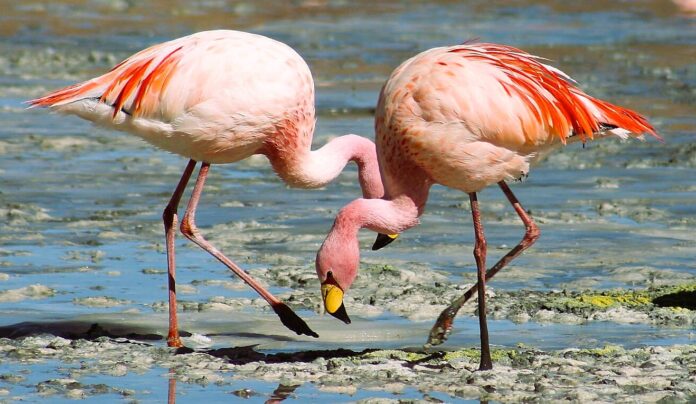
With their characteristic aura of grace and beauty, flamingos might appear calm when they are readying to savor their shrimp meal in the stillness of water.
But beneath the water surface, that is not usually the case.
Quite the opposite. Flamingos are at work almost clinically. They use their ability to maneuver a vortex, stomp dance and bring to bear their beak power to eat organisms.
A recent research shows that the elegant slender-legged birds use their feet, heads and beaks to create a “storm of swirling tornados, or vortices, in the water to efficiently concentrate and slurp up their prey.”
Science Daily reports that these revelations stem from studies of Chilean flamingos in the Nashville Zoo and analysis of 3D printed models of their feet and L-shaped bills.
Researchers working at the Georgia Institute of Technology in Atlanta; Kennesaw State University in Marietta, Georgia (KSU-Marietta); and the Nashville Zoo will publish their findings this week in the journal Proceedings of the National Academy of Sciences.

“Flamingos are actually predators, they are actively looking for animals that are moving in the water, and the problem they face is how to concentrate these animals, to pull them together and feed,” said Victor Ortega Jiménez, an assistant professor of integrative biology at the University of California, Berkeley, who specializes in biomechanics.
He adds, “Think of spiders, which produce webs to trap insects. Flamingos are using vortices to trap animals, like brine shrimp.”
Findings reveal that flamingos use their “floppy webbed feet to churn up the bottom sediment and propel it forward in whorls that the birds then draw to the surface by jerking their heads upward like plungers, creating mini tornados.”
During this surgically done process, the birds’ heads remain “upside down within the watery vortex, their angled beaks chattering to create smaller vortices that direct the sediment and food into their mouths, where it’s strained out,” according to Science Daily.
Flamingos have a unique beak, that is flattened on the angled front end, so that when the bird’s head is upside down in the water, the flat portion is parallel to the bottom.
“This allows the flamingo to employ another technique called skimming. This involves using its long, S-shaped neck to push its head forward while rapidly clapping its beak, creating sheet-like vortices — von Kármán vortices — that trap prey.”














